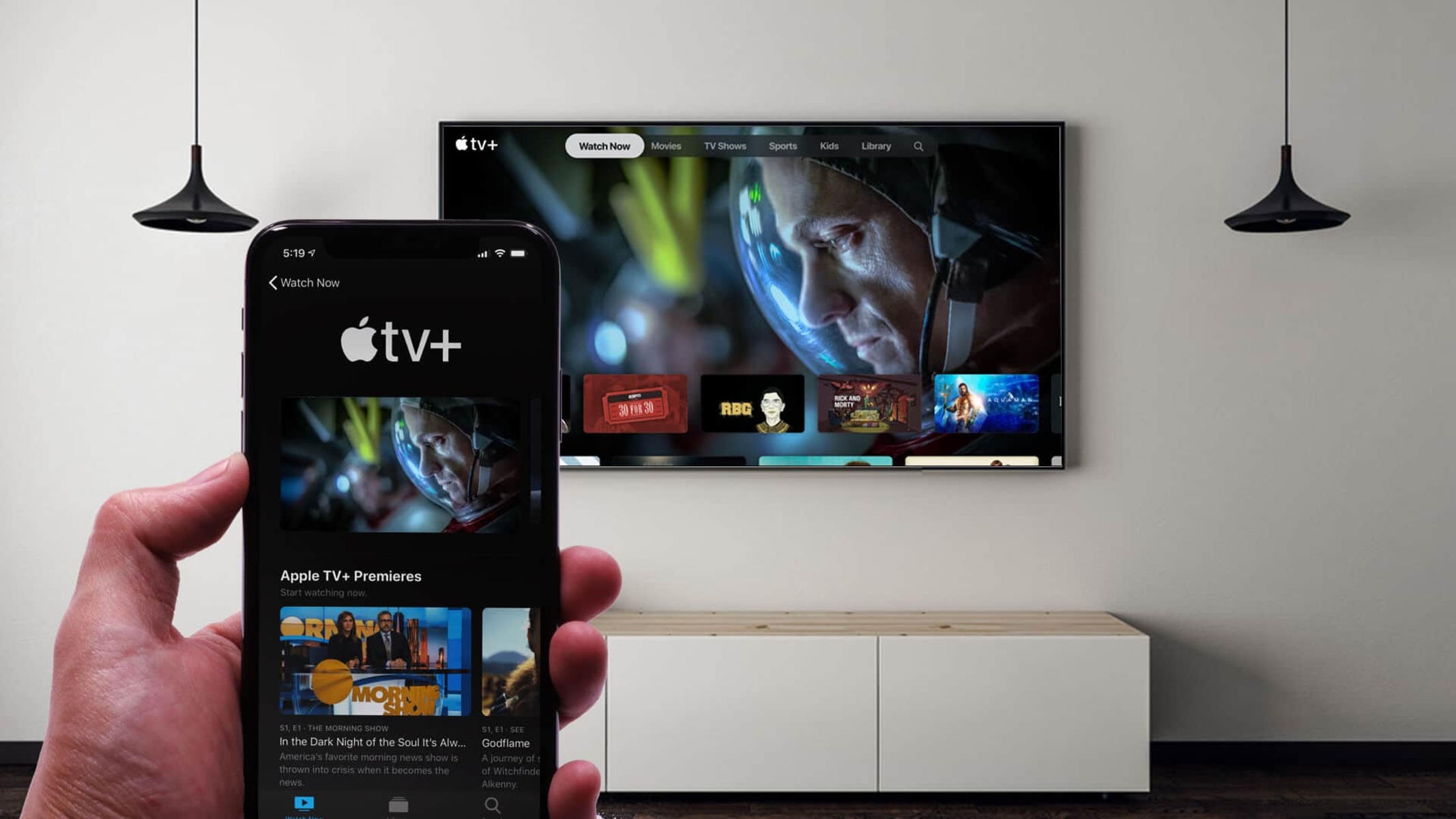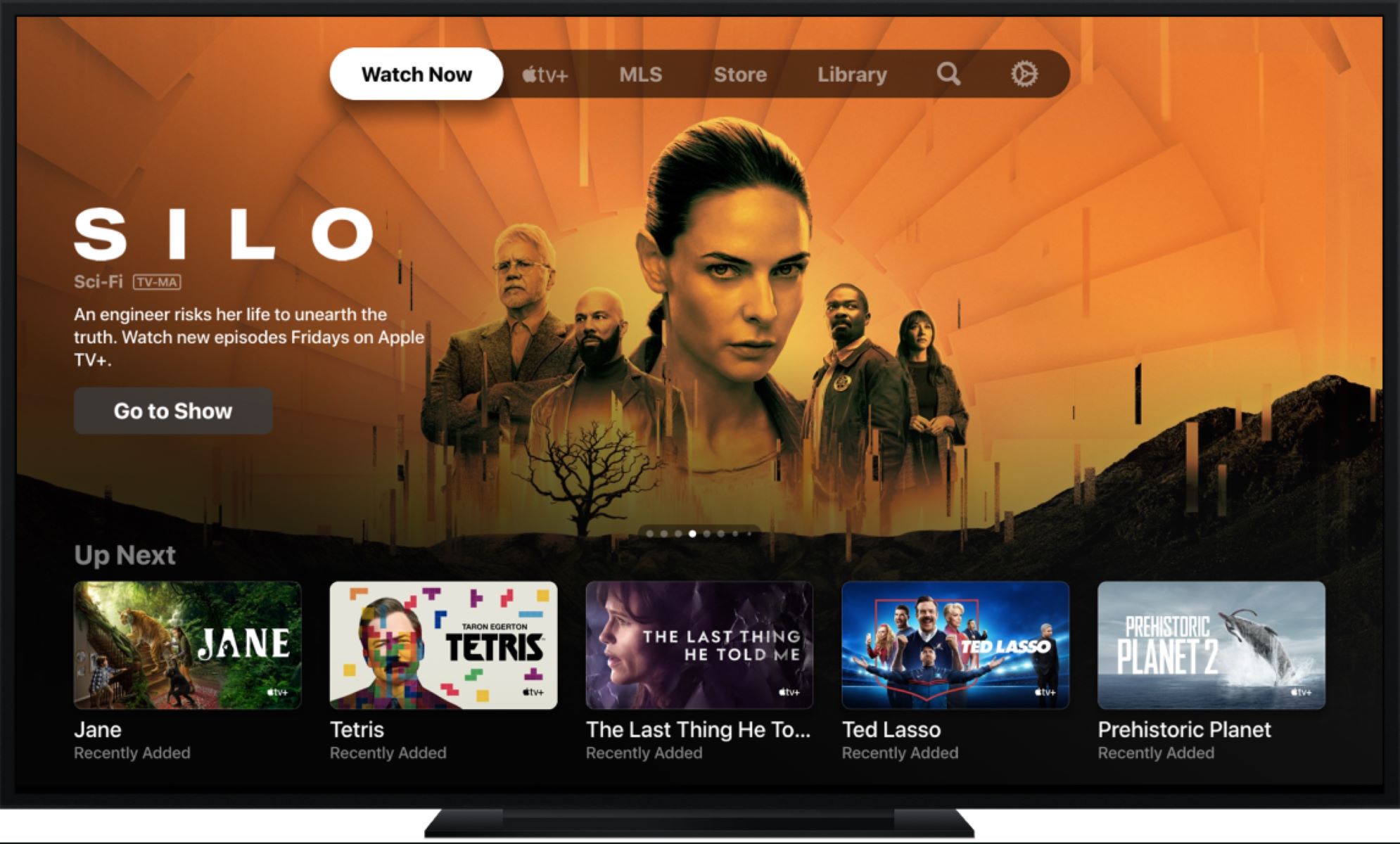Introduction
Welcome to the world of Apple TV! Whether you’re a tech enthusiast, a movie lover, or simply looking for a new way to stream your favorite content, Apple TV offers a seamless and immersive entertainment experience. With its sleek design and user-friendly interface, Apple TV allows you to access a wide range of movies, TV shows, music, and more right on your television.
In this guide, we will take you through the steps of setting up your Apple TV and connecting it to your TV. We will also explore how to connect to Wi-Fi, set up your Apple ID, download apps, and navigate the Apple TV interface. Additionally, we’ll show you how to browse and view content, use Siri to control your Apple TV, and even stream content from your iPhone, iPad, or Mac to your Apple TV. Finally, we’ll share some troubleshooting tips to help you overcome any potential hiccups along the way.
So, whether you’re a novice or a seasoned Apple user, this guide will provide you with everything you need to know to make the most out of your Apple TV and enjoy a world of entertainment at your fingertips. Get ready to immerse yourself in a new and exciting streaming experience with Apple TV!
Setting Up Your Apple TV
Setting up your Apple TV is a straightforward process that requires just a few simple steps. Let’s get started:
- Connect the HDMI cable: Begin by connecting one end of the HDMI cable to the HDMI port on your Apple TV, and the other end to an available HDMI port on your TV.
- Power it up: Connect the power cord to your Apple TV, and plug the other end into a power outlet. Turn on your TV, and set it to the correct HDMI input.
- Pair the remote: If you have a Siri Remote, press and hold the Menu and Volume Up buttons together. If you have an older Apple TV Remote, simply hold down the Menu and Left buttons. This will pair your remote with your Apple TV.
- Select language and region: Use the remote to navigate the on-screen prompts and select your preferred language and region settings.
- Connect to Wi-Fi: Choose your Wi-Fi network from the provided list and enter the password if necessary. This will ensure that your Apple TV is connected to the internet.
- Sign in with your Apple ID: If you already have an Apple ID, sign in to your account. If not, follow the on-screen instructions to create a new Apple ID. This will allow you to access the App Store and download apps on your Apple TV.
- Agree to terms and conditions: Review and accept the terms and conditions to proceed with the setup process.
- Enable location services: Decide whether you want to enable location services on your Apple TV. This can enhance your user experience by providing relevant location-based content and features.
- Choose display settings: Select the appropriate display settings for your TV, including resolution and screen size. You can also enable or disable HDR and Dolby Vision options based on your TV’s capabilities.
- Set up HomePod or other speakers (optional): If you have a HomePod or other compatible speakers, you can set them up to enhance your audio experience while using Apple TV.
Once you have completed these steps, your Apple TV will be fully set up and ready to use. You can now start exploring the wide range of content available and personalize your entertainment experience to suit your preferences.
Connecting Your Apple TV to Your TV
Connecting your Apple TV to your TV is a crucial step in the setup process. Follow these steps to ensure a proper connection:
- Turn off both your Apple TV and your TV before making any connections.
- Locate the HDMI port on your TV. It is usually marked with “HDMI” and may be labeled with a number.
- Connect one end of the HDMI cable to the HDMI port on your Apple TV.
- Connect the other end of the HDMI cable to the HDMI port on your TV, matching the numbers if applicable.
- Use your TV’s remote or the input/source button on your TV to select the HDMI input where your Apple TV is connected. This can be HDMI 1, HDMI 2, or any other available HDMI port on your TV.
- Turn on your Apple TV and your TV.
- If the connection is successful, you should see the Apple TV setup screen on your TV.
It’s important to note that if you have an older TV that does not have an HDMI port, you may need to use an HDMI to composite converter or an HDMI to component converter to connect your Apple TV. These converters allow you to connect your Apple TV to the RCA or component inputs on your TV.
Additionally, if you have a newer TV that supports HDMI-CEC (Consumer Electronics Control), you can enable this feature to control your Apple TV with your TV remote. This eliminates the need for multiple remotes and simplifies your viewing experience.
Once your Apple TV is successfully connected to your TV, you can proceed with the setup process and enjoy all the features and content available on your Apple TV.
Connecting to Wi-Fi
In order to fully utilize the features and access the content on your Apple TV, it is essential to connect it to a Wi-Fi network. Here’s how you can do it:
- On the Apple TV’s home screen, navigate to the “Settings” app using the Apple TV remote.
- From the Settings menu, select “Network.”
- Choose the “Wi-Fi” option and wait for a list of available networks to appear.
- Select your preferred Wi-Fi network from the list by highlighting it and pressing the select button on the remote.
- If your network is password-protected, use the remote to enter the Wi-Fi password. The password characters will appear as dots on the screen for security purposes.
- After entering the password, select “Join.”
- Once connected, the Apple TV will display a confirmation message, and you will see the Wi-Fi network’s name in the settings menu.
It is important to ensure that your Apple TV is within range of your Wi-Fi router for a stable and reliable connection. If you experience any issues with the Wi-Fi connection, try moving the Apple TV closer to the router or check the network settings in your router to ensure compatibility.
If you have multiple Wi-Fi networks available, it is recommended to connect your Apple TV to the 5GHz band for faster and more reliable internet access. The 2.4GHz band may be congested in crowded areas with many Wi-Fi signals.
Once your Apple TV is connected to Wi-Fi, you can start streaming your favorite movies, TV shows, music, and more from various apps and services available on the device.
Setting Up Your Apple ID
In order to fully access the features and content on your Apple TV, it is necessary to set up and sign in with an Apple ID. Your Apple ID is your gateway to the App Store, enabling you to download apps, games, and other content onto your Apple TV. Setting up your Apple ID is a simple process:
- On the Apple TV’s home screen, navigate to the “Settings” app using the Apple TV remote.
- Scroll down and select “Users and Accounts” in the Settings menu.
- Choose “Add New User” and then select “Continue.”
- There are two ways to set up your Apple ID:
- If you already have an Apple ID, select “Enter Your Apple ID” and proceed to enter your email address and password. Once entered, select “Sign In.”
- If you don’t have an Apple ID, select “Create New Apple ID” and follow the on-screen instructions to create a new account. Provide your personal information, such as name, birthdate, email address, and password. Make sure to choose a strong password that includes a combination of letters, numbers, and symbols. Once you have entered all the required information, select “Continue” to create your Apple ID.
- After signing in with your Apple ID or creating a new one, you may be prompted to set up two-step verification for added security. Follow the instructions on the screen to complete the process if desired.
- Once you have set up or signed in with your Apple ID, you can access and download apps from the App Store, rent or purchase movies and TV shows, listen to music, and take advantage of other features available on your Apple TV.
It’s worth noting that if you have multiple users on your Apple TV, each user can have their own Apple ID. This allows for personalized recommendations, preferences, and access to individual app purchases.
With your Apple ID set up, you can explore the wide variety of apps and content available on the App Store and make the most of your Apple TV experience.
Downloading Apps on Your Apple TV
One of the key advantages of owning an Apple TV is the ability to download and enjoy a wide range of apps. These apps can enhance your entertainment experience by providing access to streaming services, games, educational content, fitness programs, and more. Here’s how you can download apps on your Apple TV:
- On the Apple TV’s home screen, navigate to the “App Store” app using the Apple TV remote.
- Browse or search for the app you want to download. You can use the remote to navigate through different categories, or use the search function to find a specific app.
- Select the app you want to download by highlighting it and pressing the select button on the remote.
- On the app’s page, you can read more details about the app, including its description, ratings, and reviews.
- To download the app, click on the “Get” or “Download” button. If the app is already downloaded, it will display the “Open” button instead.
- If the app requires payment, you may be prompted to enter your Apple ID password, or use the Touch ID or Face ID feature if available.
- Wait for the app to download and install on your Apple TV. The progress will be indicated by a status bar.
- Once the app is downloaded and installed, you can access it from the home screen or via the “Apps” section of the Apple TV interface.
Remember, the availability of apps on the App Store may vary depending on your region or country. Some apps may also require a subscription or in-app purchases for full access to their features and content.
With a wide array of apps to choose from, you can personalize your Apple TV experience and enjoy the content you love, whether it’s streaming your favorite shows, playing games, or learning something new.
Navigating the Apple TV Interface
The Apple TV interface is designed to provide an intuitive and user-friendly experience, allowing you to easily navigate and access your favorite content. Here’s a breakdown of the key elements and navigation options:
- Home Screen: When you turn on your Apple TV, you’ll be greeted by the home screen, which displays a variety of apps and features. Use the touch-sensitive surface on the Apple TV remote to navigate through the different icons and options.
- Top Shelf: Located at the top of the home screen, the Top Shelf offers a preview of featured content from various apps. You can customize the Top Shelf to display your favorite apps or recommendations.
- Menu Button: Pressing the Menu button on the Apple TV remote takes you back to the previous screen or the home screen, depending on your current location within the interface.
- App Switcher: Double-pressing the Menu button on the remote opens the App Switcher, allowing you to switch between recently used apps. Scroll horizontally through the apps and select the one you want to switch to.
- App Library and Store: Access the App Library to view and manage all your installed apps. The App Store provides access to a wide range of apps that you can download and install on your Apple TV.
- Settings: The Settings app allows you to customize various aspects of your Apple TV, including network settings, display settings, sound preferences, accessibility options, and more.
- Siri: Press and hold the Siri button on the remote to activate Siri, Apple’s voice assistant. You can use Siri to control your Apple TV, search for content, get recommendations, and perform various tasks without having to navigate through menus manually.
To navigate within apps, most of them follow a similar interface design. Use the touch-sensitive surface on the remote to move the selection cursor and click to make selections within the app. Additionally, some apps may have their own unique navigation and features.
By familiarizing yourself with the layout and navigation options of the Apple TV interface, you can effortlessly move through the different screens, access your favorite apps, and enjoy a seamless entertainment experience.
Browsing and Viewing Content
With your Apple TV, you have a multitude of options for browsing and viewing content, including movies, TV shows, music, and more. Here’s how to make the most out of your content browsing experience:
- Apps: Use the app icons on your Apple TV’s home screen or navigate to the “Apps” section to access various streaming services, such as Netflix, Disney+, Hulu, and more. Each app provides a unique selection of content, including movies, TV shows, documentaries, and even live sports.
- Top Shelf Recommendations: Take advantage of the Top Shelf feature, which displays personalized recommendations for content based on your viewing habits. This feature allows you to quickly access suggested shows, movies, and playlists without having to search for them manually.
- Search: Utilize the search functionality on your Apple TV to find specific movies, TV shows, actors, or genres. Press the magnifying glass icon on the home screen or use the Siri remote to enter your search terms. Relevant results from various apps and services will be displayed for you to choose from.
- Genres and Categories: Explore different genres and categories within apps to discover new content. Most streaming apps provide easy navigation through genres like comedy, drama, action, and more. You can also browse by categories such as Trending, New Releases, or Popular.
- Continue Watching: Many apps offer a “Continue Watching” section that allows you to easily pick up where you left off in a TV show or movie. This feature keeps track of your progress, allowing you to resume playback from where you previously stopped.
- TV App: Take advantage of the TV app, which serves as a central hub for all your favorite streaming services, allowing you to browse and discover content from various providers in one place. The TV app also offers personalized recommendations and a unified Up Next queue, making it easier to keep track of your favorite shows and movies.
- AirPlay: If you have an iPhone, iPad, or Mac, you can use AirPlay to stream content directly from your device to your Apple TV. This allows you to enjoy photos, videos, music, and even mirror your device’s screen onto your TV.
With these browsing and content viewing options at your fingertips, you can easily find and enjoy a wide range of entertainment on your Apple TV. Whether you’re in the mood for a movie marathon, want to catch up on your favorite TV shows, or discover new and exciting content, your Apple TV has you covered.
Using Siri on Apple TV
Siri, Apple’s intelligent voice assistant, is integrated into the Apple TV, allowing you to control your device with just your voice. With Siri, you can search for content, open apps, adjust settings, and perform various tasks. Here’s how to make the most out of Siri on your Apple TV:
- Activating Siri: Press and hold the Siri button on the Apple TV remote to activate Siri. You’ll see a visual indication on the screen when Siri is listening.
- Voice Commands: Use natural language to give commands or ask questions to Siri. For example, say “Find action movies” or “Show me comedy TV shows.”
- Content Search: Ask Siri to find specific movies, TV shows, or actors by saying something like, “Search for The Shawshank Redemption” or “Who stars in Game of Thrones?” Siri will display search results from various apps and services available on your Apple TV.
- App Launching: Instead of navigating through menus, use Siri to open specific apps on your Apple TV. Simply say the app’s name, such as “Open Netflix” or “Launch YouTube.”
- Playback Control: Control playback with Siri. For example, say “Play,” “Pause,” “Skip forward,” or “Go back 10 minutes” to control the playback of movies or TV shows.
- Volume Control: Adjust the volume on your Apple TV using Siri. Say “Increase volume,” “Decrease volume,” or specify a specific volume level with commands like “Set volume to 50%.”
- Information and Knowledge: Ask Siri for general information, such as movie trivia, sports scores, weather updates, or even mathematical calculations.
- Settings Control: Use Siri to control settings on your Apple TV. For example, say “Turn on subtitles,” “Switch to Dark Mode,” or “Change the language to Spanish.”
- HomeKit Control: If you have smart home devices connected through HomeKit, Siri can help you control them with voice commands. For instance, you can say, “Turn off the lights” or “Set the thermostat to 72 degrees.”
Siri makes it easy and convenient to interact with your Apple TV using voice commands. It simplifies the navigation and control process, allowing for a hands-free and intuitive experience, so you can sit back, relax, and enjoy your favorite content with ease.
Streaming from iPhone, iPad, or Mac to Apple TV
One of the great features of Apple devices is their ability to seamlessly stream content to your Apple TV. Whether you want to share photos, videos, music, or even mirror your device’s screen, streaming from your iPhone, iPad, or Mac to your Apple TV is a breeze. Here’s how you can do it:
- AirPlay: AirPlay is the technology that enables wireless streaming between Apple devices. To start streaming, make sure your iPhone, iPad, or Mac is connected to the same Wi-Fi network as your Apple TV.
- Streaming from iPhone or iPad: Swipe down from the top right corner of your iPhone or iPad screen (or swipe up from the bottom on older models) to access the Control Center. Tap the “Screen Mirroring” or “AirPlay” button and select your Apple TV from the list. You can now stream your device’s screen or specific media content to your Apple TV.
- Streaming from Mac: On your Mac, click on the AirPlay icon located in the menu bar (it looks like a rectangle with an upward arrow). Choose your Apple TV from the list of available devices and select whether you want to mirror your entire screen or extend your desktop. You can also stream specific media content from apps like Safari, iTunes, or QuickTime Player by clicking the AirPlay icon within the app and selecting your Apple TV.
- Photos and Videos: With AirPlay, you can easily share your photos and videos from your iPhone, iPad, or Mac on the big screen. Open the Photos app on your device, find the photo or video you want to share, and tap the AirPlay or Share icon. Choose your Apple TV from the list, and the media will be displayed on your TV.
- Music and Audio: Stream your favorite music or podcasts from your iPhone, iPad, or Mac to your Apple TV. Open the Music or Podcasts app and play the desired content. Tap the AirPlay or Now Playing icon, and select your Apple TV to start streaming the audio.
Streaming from your iPhone, iPad, or Mac to your Apple TV allows you to enjoy your content on a larger screen and enhance your viewing or listening experience. It’s a convenient and versatile way to share and consume media across your Apple devices.
Troubleshooting Tips
While Apple TV is designed to provide a seamless and enjoyable entertainment experience, you may encounter some issues along the way. Here are some troubleshooting tips to help you resolve common problems and ensure smooth operation:
- Check your internet connection: Ensure that your Apple TV is connected to a stable Wi-Fi network. If you’re experiencing connectivity issues, try restarting your router or moving your Apple TV closer to the Wi-Fi source.
- Restart your Apple TV: A simple restart can often resolve minor glitches or performance issues. Go to Settings and select System, then scroll down and choose Restart. Alternatively, you can unplug the power cord from your Apple TV, wait a few seconds, and plug it back in.
- Update your Apple TV: Regularly check for software updates on your Apple TV. Having the latest software version ensures that you have access to the latest features and bug fixes. Go to Settings, select System, then choose Software Updates to check for any available updates.
- Re-pair your Apple TV remote: If your Apple TV remote is not responding or experiencing connectivity issues, you can try re-pairing it. Go to Settings, select Remotes and Devices, then choose Remote. Follow the on-screen instructions to re-pair your remote with your Apple TV.
- Reset your Apple TV: If you’re experiencing persistent issues and other troubleshooting steps haven’t resolved the problem, you may consider resetting your Apple TV to its factory settings. Go to Settings, select System, then choose Reset. Keep in mind that this will erase all of your Apple TV’s settings and content, so be sure to back up any important data beforehand.
- Check HDMI connections: Ensure that your HDMI cable is securely connected to both your Apple TV and your TV. If you’re experiencing video or audio issues, try disconnecting and reconnecting the HDMI cable from both ends.
- Try a different HDMI port or cable: If you’re encountering display or audio issues, there may be an issue with the HDMI port on your TV or the cable itself. Try connecting your Apple TV to a different HDMI port on your TV or using a different HDMI cable to determine if the problem lies with the port or cable.
- Contact Apple Support: If you’ve tried the above troubleshooting steps and are still experiencing issues with your Apple TV, it’s best to reach out to Apple Support for further assistance. They can provide you with tailored solutions or advise on possible hardware issues if needed.
Remember that troubleshooting may vary depending on the specific issue and your Apple TV model. Consulting the official Apple support resources or contacting Apple Support directly can provide you with the most accurate and up-to-date guidance for resolving your particular issue.
Conclusion
Congratulations! You have now reached the end of our guide on how to watch Apple TV on your TV. We’ve covered everything from setting up your Apple TV and connecting it to your TV to browsing and streaming content, using Siri, and troubleshooting common issues. By following the steps outlined in this guide, you should have a seamless and enjoyable experience using your Apple TV.
With your Apple TV, you have access to a vast array of movies, TV shows, music, and apps, all conveniently available on your TV screen. Whether you’re streaming your favorite shows, playing games, or exploring educational content, your Apple TV can provide hours of entertainment for you and your family.
Remember to keep your Apple TV updated with the latest software and take advantage of features like AirPlay and Siri, which allow you to stream content from your other Apple devices and control your Apple TV using just your voice.
If you encounter any issues or need further assistance, don’t hesitate to refer back to this guide or reach out to Apple Support for personalized help. They are always ready to assist you and ensure that you make the most of your Apple TV experience.
Thank you for choosing Apple TV, and happy streaming!
























